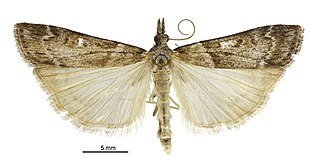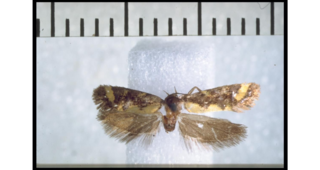
Aponotoreas is a genus of moths in the family Geometridae erected by Robin C. Craw in 1986.

Austrocidaria is a genus of moths in the family Geometridae. It was described by John S. Dugdale in 1971.

Sagephora is a genus of moths belonging to the family Tineidae.

Scoparia scripta is a species of moth in the family Crambidae. It is endemic in New Zealand.

Scoparia caliginosa is a species of moth in the family Crambidae. It is endemic to New Zealand.

Scoparia declivis is a species of moth in the family Crambidae. It is endemic to New Zealand.

Trachypepla semilauta is a moth of the family Oecophoridae and was first described by Alfred Philpott in 1918. It is endemic to New Zealand and has been collected in Southland. This species inhabits southern beech forest on the side of mountains. Adults are on the wing in January.

Heterocrossa is a genus of moths in the Carposinidae family. It is endemic to New Zealand. This genus was previously regarded as a synonym of the genus Carposina. However Elwood C. Zimmerman in Insects of Hawaii removed Heterocrossa from synonymy with Carposina. Zimmerman argued that as the genitalia of Heterocrossa and Carposina are distinct, Heterocrossa should not be regarded as a synonym of Carposina. This was agreed with by John S. Dugdale in his annotated catalogue of New Zealand lepidoptera.

Hierodoris is a genus of moths in the family Oecophoridae. It was first described by Edward Meyrick in 1912. This genus is only known from New Zealand. In 1988 the genus Taoscelis was synonymised with Hierodoris. In 2005 the genus Coridomorpha was synonymised with Hierodoris.

Thylacosceles is a genus of moths in the family Stathmopodidae.
Merlin Owen Pasco was a New Zealand entomologist. Pasco discovered several species of moth previously unknown to science and collected numerous specimens.

Aponotoreas incompta is a moth of the family Geometridae. It is endemic to New Zealand.

Sagephora exsanguis is a species of moth in the family Tineidae. It was described by Alfred Philpott in 1918. This species is endemic to New Zealand and has been found on Cuvier Island, as well as the North and South Islands. The adults of this species are on the wing from October to December.

Tingena is a genus of the concealer moth family (Oecophoridae). This genus is endemic to New Zealand.

Hierodoris stellata is a species of moth in the family Plutellidae. It is endemic to New Zealand and is found in Fiordland and Dunedin. This species has been found in coastal native forest. Larvae feed on Astelia flower-spikes and adults are on the wing in late December and January. It has been stated that this species belongs to the genus Charixena however this placement has yet to be published. As such this species is currently known as Hierodoris (s.l.) stellata or 'Hierodoris'stellata.

Tingena honorata is a species of moth in the family Oecophoridae. It is endemic to New Zealand and has been observed in the South Island including in Fiordland, Southland and Otago. This species has inhabits damp openings in native forest. The adults of this species are on the wing in December and January and are attracted to light.

Hydriomena canescens is a species of moth in the family Geometridae. It was first described by Alfred Philpott in 1918. This species is endemic to New Zealand. The classification of New Zealand endemic moths within the genus Hydriomena is regarded as unsatisfactory and in need of revision. As such this species is currently also known as Hydriomena (s.l.) canescens.

Thylacosceles acridomima is a moth of the family Stathmopodidae. This species is endemic to New Zealand. It was first described by Edward Meyrick in 1889.

Trachypepla is a genus of moths of the family Oecophoridae. It was circumscribed in 1883 by Edward Meyrick. The species within this genus are indigenous to Australia and New Zealand.




















